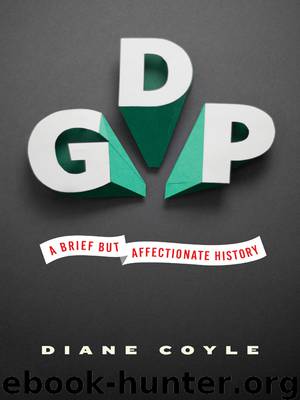GDP by Coyle Diane

Author:Coyle, Diane
Language: eng
Format: epub
Publisher: Princeton University Press
Published: 2014-09-01T16:00:00+00:00
THE EXPLOSION OF VARIETY
A seemingly separate issue, also of increasing salience, is that the way GDP is measured makes it impossible to capture fully the effect of innovation. Innovation is constant, but in the 1990s it was apparent that a new wave of products and services based on information and communications technologies was starting to feature significantly in the spending of businesses and consumers.
Why does GDP not measure innovation well? Brad DeLong, the University of California–Berkeley economic historian, has given the example of successive innovations in lighting the home. There was a progression from expensive, smoky tallow candles, rarely used and giving out little light and much smoke, in the preindustrial era, to kerosene lanterns, to gas lighting, to modern electric lights at the touch of a switch. In the 1500s, most people went to bed whenever it grew dark, so expensive was the poor-quality light available to them. By the 1990s, you could go on holiday leaving the lights on by accident, and realize your mistake with only a mild pang of annoyance. Over the decades and centuries, the price of a lumen or unit of light fell dramatically. At the same time, the quality of lighting increased profoundly.10 The raw statistics that go into the estimates of GDP—the number of candles bought or the number of light bulbs and lamps—never fully captured the scale of either the decline in price or the improvement in quality. According to William Nordhaus, in a famous study, conventional measurement had overestimated the price of light, and underestimated the real output, by a factor of between 900 and 1,600 since the beginning of the nineteenth century. If true of other technologies where there was rapid advance, this would add up to a significant underestimate of real growth in the GDP statistics.
What is true of this one item of consumer spending is true across the entire economy. Modern GDP growth is a story of continuing innovation and an explosion in variety. It has been rather fashionable to claim there is “too much” choice. The evidence points the other way. Econometric estimates of the value consumers derive from additional varieties of certain products, say of cereals, or book titles, indicate that this is large even for seemingly trivial innovations like apple cinnamon flavor Cheerios.11 What must the benefit be when adding together everything from minor innovations in cereals, toothpastes, and flavors of tea, through more obviously novel innovations such as Velcro fastening or hybrid cars, to those we normally think of as high-tech, like smartphones and tablet computers, genetically targeted pharmaceuticals, and new materials such as graphene?
The question of how to account in GDP for dramatic changes in quality and declines in price became particularly acute in the case of computers by the mid-1990s. In the space of ten years, we had moved from a relatively small number of early adopter consumers with their Apple Lisas or Macintoshes to widespread ownership of more powerful home computers, including rapidly growing Internet use at home, plus increasingly
Download
This site does not store any files on its server. We only index and link to content provided by other sites. Please contact the content providers to delete copyright contents if any and email us, we'll remove relevant links or contents immediately.
International Integration of the Brazilian Economy by Elias C. Grivoyannis(99548)
The Radium Girls by Kate Moore(11978)
Turbulence by E. J. Noyes(7983)
Nudge - Improving Decisions about Health, Wealth, and Happiness by Thaler Sunstein(7662)
The Black Swan by Nassim Nicholas Taleb(7064)
Rich Dad Poor Dad by Robert T. Kiyosaki(6519)
Pioneering Portfolio Management by David F. Swensen(6261)
Man-made Catastrophes and Risk Information Concealment by Dmitry Chernov & Didier Sornette(5958)
Zero to One by Peter Thiel(5736)
Secrecy World by Jake Bernstein(4703)
Millionaire: The Philanderer, Gambler, and Duelist Who Invented Modern Finance by Janet Gleeson(4425)
The Age of Surveillance Capitalism by Shoshana Zuboff(4253)
Skin in the Game by Nassim Nicholas Taleb(4208)
Bullshit Jobs by David Graeber(4143)
The Money Culture by Michael Lewis(4141)
Skin in the Game: Hidden Asymmetries in Daily Life by Nassim Nicholas Taleb(3964)
The Dhandho Investor by Mohnish Pabrai(3729)
The Wisdom of Finance by Mihir Desai(3699)
Blockchain Basics by Daniel Drescher(3544)
